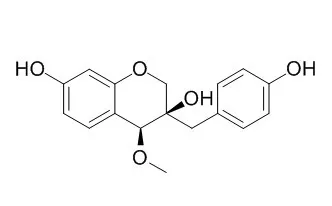Sappanwood (Caesalpinia sappan Linn.) is used as an herbal medicine. It is sometimes used to treat skin damage or as a facial cleanser.
METHODS AND RESULTS:
In the present study, the methanol (MeOH) extract of sappanwood was found to inhibit melanin synthesis in cultured human melanoma HMV-II cells stimulated with forskolin, and six active compounds (1-5 and 7) were isolated from the extract along with a non-active compound (6). Compounds 2-7 were identified as sappanchalcone (2), 3'-Deoxy-4-O-methylsappanol (3), brazilein, (4), brazilin (5), sappanol (6), and 4-O-methylsappanol (7). Compound 1 was a new compound, and its structure was determined to be (6aS,11bR)-7,11b-dihydro-6H-indeno[2,1-c]chromene-3,6a,10,11-tetrol by spectroscopic analyses. Among the six active compounds, brazilin (5) (EC50: 3.0 ± 0.5 µM) and 4-O-methylsappanol (7) (EC50: 4.6 ± 0.7 µM) strongly suppressed melanin synthesis in HMV-II cells. Bioactive compounds showed moderate cytotoxicities against HMV-II cells with IC50 values of 83.1 ± 4.0 µM (for 2), 72.0 µM ± 2.4 (for 3), 33.8 ± 1.1 µM (for 4), 18.4 ± 0.8 µM (for 5), and 20.2 ± 0.8 (for 7), respectively. Brazilin (5) selectively suppressed the expression of mRNAs for tyrosinase-related protein (TYRP) 2 and tyrosinase but did not influence the expression of TYRP1.
CONCLUSIONS:
These results suggest that brazilin (5) is a new class of melanin inhibitor and that sappanwood could be used as a cosmetic material. |






 Cell. 2018 Jan 11;172(1-2):249-261.e12. doi: 10.1016/j.cell.2017.12.019.IF=36.216(2019)
Cell. 2018 Jan 11;172(1-2):249-261.e12. doi: 10.1016/j.cell.2017.12.019.IF=36.216(2019) Cell Metab. 2020 Mar 3;31(3):534-548.e5. doi: 10.1016/j.cmet.2020.01.002.IF=22.415(2019)
Cell Metab. 2020 Mar 3;31(3):534-548.e5. doi: 10.1016/j.cmet.2020.01.002.IF=22.415(2019) Mol Cell. 2017 Nov 16;68(4):673-685.e6. doi: 10.1016/j.molcel.2017.10.022.IF=14.548(2019)
Mol Cell. 2017 Nov 16;68(4):673-685.e6. doi: 10.1016/j.molcel.2017.10.022.IF=14.548(2019)